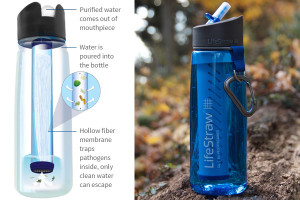Did you know its easy to have clean drinking water anywhere in the world with one little straw? The LifeStraw Go water bottle should be in every outdoor enthusiast’s pack. It makes any type of contaminated water safe to drink. No matter what sports you pursue in the mountain, we all find ourselves in the wilderness at some point with no potable water nearby. In Aspen this might be as close as the Hunter Creek trail, but now you will never run out of water.

I have never been too trusting of water filtration systems. As my mom used to say “there is always an animal living higher in the mountains than you are.” For this reason, I have always been wary of drinking from streams, no matter how pure you think it might be. I tend to try and carry as much water as I think I will need, but this usually means a lot of additional weight, and invariably I never bring enough and am either parched or mooching by the end of an adventure.
Recently on the river I saw a girl pull a blue plastic straw from her life jacket, lean over and drink through it straight from the Roaring Fork River. It was a LifeStraw, and after some research found that its also a filtration system built into a water bottle. The bottle is sturdy and ultralight, weighing less than 6 ounces, and able to hold 22 ounces, with a convenient carabineer to clip right to you backpack.
The LifeStaw uses a two stage filtration system. The first is hollow fiber membrane technology (0.2 microns) to remove waterborne bacteria and parasites, up to 99.999% which includes E Coli and Giardia. The second stage is a replaceable carbon capsules to reduce bad taste, chlorine and organic chemical matter for up to 100 liters (26 gallons). This is like putting a Brita on your Brita. TheLifeStraw also had an infinite shelf life, so even if you don’t need to use it for years, it will be ready when you suddenly find yourself in need. And after you have drank the 26 gallons, the straw stops working, so you can’t accidently drink bad water.
LifeStraw started in 1994, developed to filter Guinea worm larvae from water it was contaminating. This system evolved into large scale water filtration systems in developing countries and disaster areas where clean water is unavailable. Staying true to their roots a portion of every LifeStraw product goes toward the community purifiers which are distributed to schools in developing communities. As a result, each consumer purchase provides one school child in a developing community with safe water for an entire school year.
So now I leave the house with a water bottle filled from home, but know that I can never run out. The LifeStraw will also be coming on every overseas trip for the foreseeable future. You can literally fill up your bottle at a river, stream, or even a puddle, screw on the lid, and sip filtered water through the mouthpiece. For the price point of $49.95 clean water everywhere is priceless.